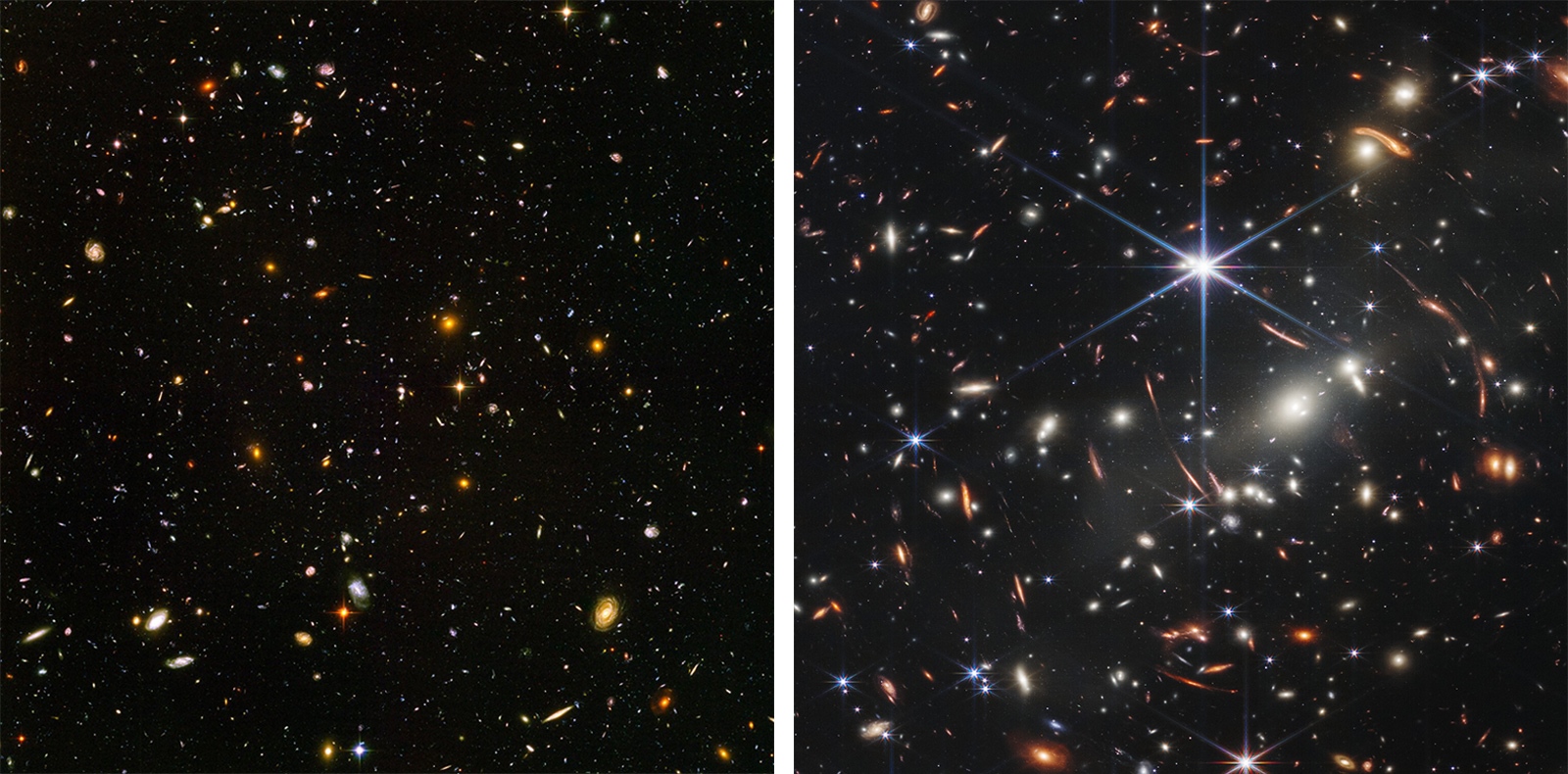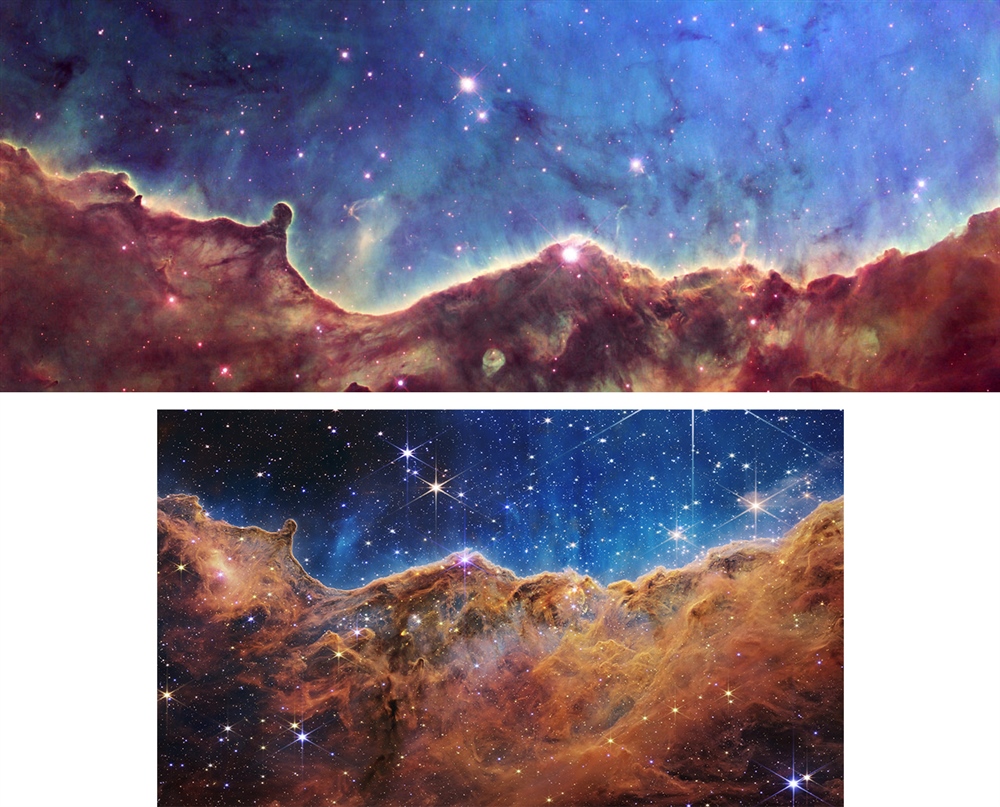By Bridgette Byrd O’Connor
The end of the school year is approaching at the speed of light. What better way to wrap up students’ learning voyage than by looking to the future to understand the past? That might seem a little weird. After all, in BHP and WHP, we’re more used to the idea of using the past to prepare for the future. But given the recent pace of innovations, our future selves might soon be answering a lot of questions about the past, in particular questions about the history of the early Universe. Nothing illustrates this more than the launch of the James Webb Space Telescope (JWST) and the images it’s been sending us over the past school year.
The JWST is a time machine that takes us back 13.5 billion years in our cosmic history. It’s the successor to the Hubble Space Telescope, but Webb is 100 times more powerful, allowing us to peer deeper into space and travel further into the history of the Universe. Scientists are getting fascinating glimpses of the Universe, including data on the earliest stellar nurseries and the atmospheres of exoplanets. But the telescope is also providing images and data that have called into question the standard theory of the origins of the earliest galaxies in our Universe. For example, in Unit 3 of the Big History Project, students learn that the early Universe was “very, very simple,” but data from the JWST has indicated that the early Universe may not have been as simple as we thought. All this new data and questioning of theories that most scientists have accepted for quite some time may seem overwhelming, but it’s also a perfect example of the power of collective learning. Big History provides us with so many illustrations of the collective learning that’s responsible for how our knowledge of the Universe has changed over time, so it’s incredibly exciting to share with students how collective learning is impacting our understanding of our cosmic history in real time.
The JWST mission is a collective, international effort, thanks to the cooperation of NASA, the European Space Agency, and the Canadian Space Agency. Beyond that, thousands of scientists all around the world are independently analyzing the data sent back from the telescope in real time, which has accelerated our collective learning. The JWST began transmitting data less than a year ago, and it’s expected to continue providing us with data for a decade. The scientific discoveries that could come from the examination of this data boggle the mind.
So, what new discoveries—and mysteries—has the JWST conjured up thus far? For starters, we now have a more detailed infrared image of the deep field Hubble transmitted almost two decades ago.
 Left: Hubble’s ultra-deep field image. Courtesy of NASA, ESA, and S. Beckwith (STScI) and the HUDF Team. Right: JWST’s infrared deep-field image. Courtesy of NASA, ESA, CSA, and STScI.
Left: Hubble’s ultra-deep field image. Courtesy of NASA, ESA, and S. Beckwith (STScI) and the HUDF Team. Right: JWST’s infrared deep-field image. Courtesy of NASA, ESA, CSA, and STScI.
Another image from the first release of the JWST data gave us an even more stunning image of the “Cosmic Cliffs” than the one Hubble sent us just 17 years ago. The JWST’s infrared cameras can peer through the gaseous dust and illuminate the birth of stars in this stellar nursery.
 Top: Hubble’s image of the Carina Nebula. Courtesy of NASA, ESA, and the Hubble Heritage Team (STScI/AURA). Bottom: JWST’s image of the “Cosmic Cliffs” in the Carina Nebula. Courtesy of NASA, ESA, CSA, and STScI.
Top: Hubble’s image of the Carina Nebula. Courtesy of NASA, ESA, and the Hubble Heritage Team (STScI/AURA). Bottom: JWST’s image of the “Cosmic Cliffs” in the Carina Nebula. Courtesy of NASA, ESA, CSA, and STScI.
But the JWST has beamed back much more than just some cool new Hubble images. The infrared cameras of the JWST also give us images from much earlier in our Universe’s history, about 300 million years after the Big Bang, as the first stars and galaxies formed during Threshold 2: Stars Light Up. Scientists have thus far identified hundreds of potential galaxies that formed between 300 and 500 million years after the Big Bang, with four early galaxies recently confirmed spectroscopically. The massive size of these early galaxies has raised questions about our standard theory of galaxy formation after the Big Bang. We used to believe that early galaxies would have been small in comparison with later galaxies like the Milky Way. And early galaxy formation is just one branch of the many studies scientists are conducting using the data from the JWST—how cool is that!
The data streaming back from the JWST might help us find life on other planets—imagine how that might transform Threshold 5: Life! A quarter of the JWST’s observation time is allocated to the study of exoplanets, which means that the JWST will be able to study about 80 to 100 exoplanets in a year. It took about 10 years for Hubble to transmit that amount of data. According to astronomer Dr. Hannah Wakeford, the data transmitted from JWST “will represent a paradigm shift in our understanding” of exoplanets.[1] Scientists have already made astounding observations of exoplanets and their atmospheres in the short amount of time that the JWST has been sending data. For example, data indicates that the hot gas giant exoplanet WASP-39b has an atmosphere partially composed of sulfur dioxide, “a molecule produced from chemical reactions triggered by high-energy light from the planet’s parent star.” The scientist responsible for this discovery, Shang-Min Tsai at the University of Oxford, commented that “This is the first time we see concrete evidence of photochemistry … on exoplanets.”[2] As students will know from Threshold 5, photochemistry was a necessary ingredient for life on Earth. Considering the JWST has years of exoplanetary observations left to perform, the chances of finding an exoplanet with an atmosphere capable of sustaining life are pretty high.
But wait…there’s more! The JWST has recently—as in three days before I finished writing this blog—found the potential for planet formation in an unlikely place. The Small Magellanic Cloud, one of the galaxies nearest our own, was once thought of as a place where new planet formation would be quite low due to its low concentration of elements heavier than hydrogen and helium. Observing a region of the Small Magellanic Cloud that has a “highly active star-formation region” allows scientists to understand how planets may have formed during the early Universe when there was a lower concentration of heavier elements. As NASA’s Stefanie Milam says, “It’s giving us a lot more area to start searching for planet formation and star formation beyond what we had originally presumed.”[3] And these are just a few of the discoveries scientists have made in the first year of JWST’s mission. New observations, data, and analysis are happening at such an incredible speed that it’s hard to keep up. Pieter van Dokkum summed it up nicely when he wrote that scientists “are racing to catch up to the firehose of fresh data” coming from the JWST.[4]
 Atmospheric composition of the hot gas giant exoplanet WASP-39b. Courtesy of NASA, ESA, CSA, and Joseph Olmstead (STScI).
Atmospheric composition of the hot gas giant exoplanet WASP-39b. Courtesy of NASA, ESA, CSA, and Joseph Olmstead (STScI).
Big History and World History Project teachers have been extolling the amazing achievements of collective learning for years. But the collaboration, data, and collective learning potential from the JWST will dramatically accelerate our potential understanding of our Universe and its origin story. Ending the year discussing some of these amazing discoveries should inspire your students to continue learning, even though it’s almost summer!
About the author: Bridgette Byrd O’Connor holds a DPhil in history from the University of Oxford and taught the Big History Project and World History Project courses and AP® US government and politics for 10 years at the high-school level. In addition, she’s been a freelance writer and editor for the Crash Course World History and US History curricula. She’s currently a content manager for the OER Project.
Cover image: Pillars of Creation image taken using the JWST’s near-infrared camera and mid-infrared instrument. Released on November 30, 2022. Courtesy of NASA, ESA, CSA, STScI, Joseph DePasquale, Alyssa Pagan, and Anton M. Koekemoer.
[1] “Exploring Exoplanets with JWST,” narrated by Iain Todd, BBC Sky at Night Magazine, BBC, August 22, 2022.
[2] Brennan, P, “NASA’s Webb Reveals an Exoplanet Atmosphere as Never Seen Before,” NASA, November 22, 2022. https://exoplanets.nasa.gov/news/1715/nasas-webb-reveals-an-exoplanet-atmosphere-as-never-seen-before/
[3] Valero, Myriam V, “JWST Spots Planetary Building Blocks in a Surprising Galaxy,” Nature, April 24, 2023. https://www.nature.com/articles/d41586-023-01418-x
[4] Van Dokkum, P, “An Exciting Era of Exploration,” Nature Astronomy, 2023. https://www.nature.com/articles/s41550-023-01946-6
 For full access to all OER Project resources AND our amazing teacher community,
For full access to all OER Project resources AND our amazing teacher community, 
